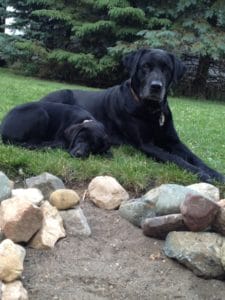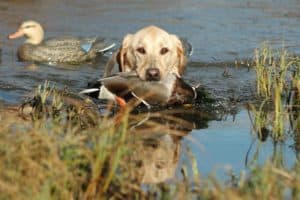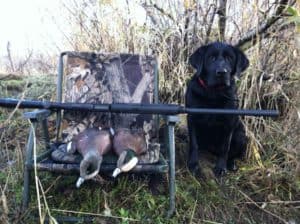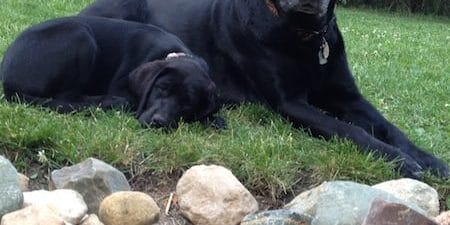by M.D. Johnson
You roll the dice and take your chances. Life’s like that, and so too can be the process of picking a pup to become your next hunting dog.

Picking a pup to become your next hunting buddy should not be a snap decision. That pup will be with you a long time, both in the field and as part of the family.
However, while luck certainly plays a role in your pup turning into a great hunting companion, there are ways to ensure the cards fall in your favor when it comes to the pick of the litter.
Breeds of dogs are better suited for different types of hunting—pointers for upland birds, beagles and hounds for trailing and running game, and retrievers for waterfowl hunting. We will focus on retrievers, but much of the expert advice on picking a pup applies to dogs used for other hunting situations—and even for pup that’s going to be strictly a pet.
Nick Hall, owner of Hall Kennels in Defiance, Missouri, has been training dogs professionally since 2005, and he has come to know a thing or two about making those oh-so-important decisions on picking a pup.
So, too, has Tony Vandemore, co-owner of Habitat Flats in Sumner, Missouri. Tony is one of the most recognizable waterfowlers in the country. Vandemore’s current go-to retriever is “Ruff and Tough Grandpa Ki.” Ki was trained by Hall, and is living up to his father, Ruff’s, legendary reputation as a top retriever and hunting companion.
Choosing A Breed
Hall said where you hunt can be a determining factor in the breed of dog a prospective owner might consider.
“In the past,” he said, “I’ve trained some very nice poodles. If you’re hunting shallow flooded fields in a moderate climate like southern Arkansas, a poodle might be perfect. You might not need a Chesapeake in a situation like this. And if you’re going to keep a dog inside, poodles don’t shed,” he continued. “A lot depends on the environments being hunted regularly.”

Does color matter when choosing a Lab as your hunting companion? There are strong opinions on all Lab varieties.
Always to the point, Vandemore’s reply was monosyllabic. “Labs.”
Without a doubt, Labrador retrievers are the most popular breed for waterfowl hunters, and they’re also a great breed as a family pet. For most, a hunting Lab will become both a working dog and a beloved part of the family.
Does Color Matter?
Labs come in three varieties—black, yellow and chocolate. Lab lovers have strong opinions on which is the best.
“From a mind-stability standpoint,” said Hall, “I believe that black and yellow Labs are more stable. Chocolates—it’s been my experience—sometimes have some small aggression issues. Don’t get me wrong,” he cautioned, “I’ve seen some great chocolates over the years. I just haven’t seen trainability differences between black and yellow as I have, at times, with the chocolates.”
On the subject of retriever color, Vandemore was again succinct. “Black,” he said without hesitation. That’s all, just black.
Male Or Female?

A pup that’s going to turn into a hunting dog will hopefully have the drive it takes to retrieve in tough conditions, yet have an “off” switch when it’s not the dog’s time to hunt.
Hall said, “With a male, it’s been my experience that you have a better chance of a dog turning out. You can have an exceptional female, but it’s harder to find an excellent female. Females do,” he continued, “seem a bit easier to handle. They can be a bit more compliant, which is always good. And if they display all the drive and get-up-and-go of a male, and are more compliant—well, there you go.”
“I prefer males,” said Vandemore, “always have. You hear that males are stronger and a little tougher physically, but I’ve had the pleasure of hunting over some awfully good females over the years—females that were tough as nails. It’s really personal preference. For me, though, it’s males. I don’t want to have to worry about a dog being in heat during hunting season.”
Pick A Pup From The Litter
“At the end of the day,” Hall said, “picking a puppy is still just an educated guess. A lot of times, I’ll actually pick the dog for the person based on what I know of the dog and what I know about the person. A personality match, so to speak. If the dog has drive and ambition, they can be trained. But what are you, the hunter, looking to live with all the time? Is it going to be in the kennel all the time? Or is it going to be around you all the time? Is it a high energy dog, and, if so, is that high energy level going to get annoying in time? It doesn’t always work,” Hall continued, “but my goal is to try to find that dog for that person. It’s kind of like Match.com for hunters and their new dogs.”
On picking a pup, Vandemore said, “Again, it’s a matter of personal preference. It’s what you want in a dog. For me, I want one that has a ‘switch.’ When it’s time for him to retrieve, he’s 110 percent in the game. But he has an off switch when he’s not in the field, and it isn’t his turn. A good dog is always ready to go but quiet off the field. I don’t care for a retriever that’s wound up all the time—he can’t sit still, whines, or is breaking all the time.
“And it’s often a fine line,” Vandemore continued. “When looking at a litter of pups, I want to see one that’s curious—not afraid to go off on his own, and doesn’t get pushed around by the other pups. When I picked Ki, Nick threw a duck wing into the puppy pile. Ki immediately grabbed it and took off. Eventually, the other pups started chasing him and trying to take the wing away, but he didn’t give it up. Ki wasn’t the biggest pup in the litter, but he was agile and quick.”
Weight is a consideration if you’re hunting a lot from boats or difficult blind situations. There’s been a trend to breed for bigger Labs, but many die-hard hunters don’t want a huge dog in the field.
“Ultimately, I prefer a dog that weighs about 60 pounds when he’s at his hunting weight,” Vandemore said.
The Union Sportsmen’s Alliance website is designed to provide valuable articles about hunting, fishing and conservation for members of AFL-CIO affiliated labor unions and all sportsmen and sportswomen who appreciate hunting and fishing and want to preserve our outdoor heritage for future generations. If you would like your own story and experience from the outdoors to be considered for our website, please email us at [email protected].




